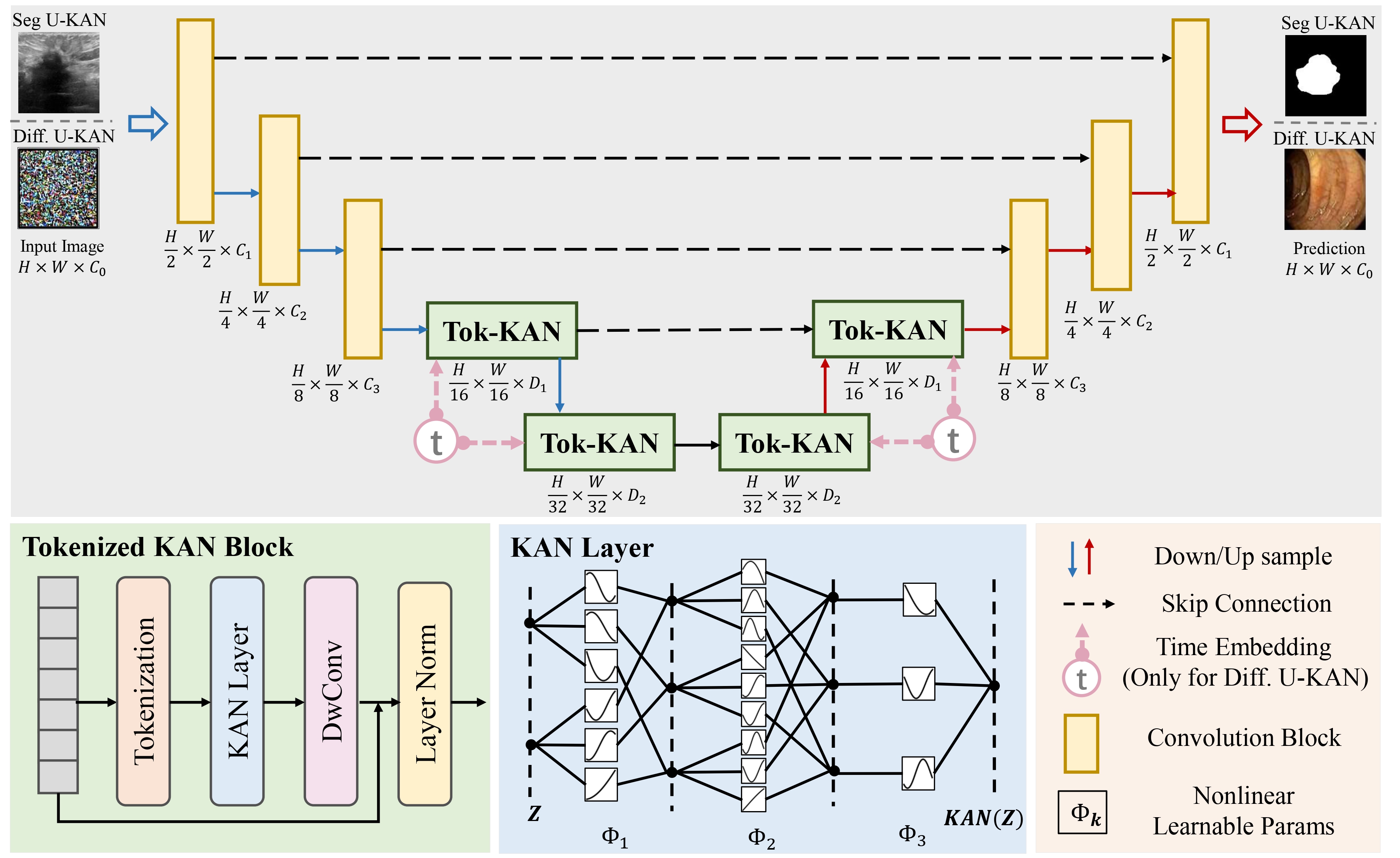📌 This is an official PyTorch implementation of U-KAN Makes Strong Backbone for Medical Image Segmentation and Generation
[Project Page] [arXiv] [BibTeX]
U-KAN Makes Strong Backbone for Medical Image Segmentation and Generation
Chenxin Li1*, Xinyu Liu1*, Wuyang Li1*, Cheng Wang1*, Hengyu Liu1, Yifan Liu1, Chen Zhen2, Yixuan Yuan1✉
1The Chinese Univerisity of Hong Kong, 2Centre for Artificial Intelligence and Robotics, Hong Kong
We explore the untapped potential of Kolmogorov-Anold Network (aka. KAN) in improving backbones for vision tasks. We investigate, modify and re-design the established U-Net pipeline by integrating the dedicated KAN layers on the tokenized intermediate representation, termed U-KAN. Rigorous medical image segmentation benchmarks verify the superiority of U-KAN by higher accuracy even with less computation cost. We further delved into the potential of U-KAN as an alternative U-Net noise predictor in diffusion models, demonstrating its applicability in generating task-oriented model architectures. These endeavours unveil valuable insights and sheds light on the prospect that with U-KAN, you can make strong backbone for medical image segmentation and generation.
[2024.6] Some modifications are done in Seg_UKAN for better performance reproduction. The previous code can be quickly updated by replacing the contents of train.py and archs.py with the new ones.
[2024.6] Model checkpoints and training logs are released!
[2024.6] Code and paper of U-KAN are released!
- The first effort to incorporate the advantage of emerging KAN to improve established U-Net pipeline to be more accurate, efficient and interpretable.
- A Segmentation U-KAN with tokenized KAN block to effectively steer the KAN operators to be compatible with the exiting convolution-based designs.
- A Diffusion U-KAN as an improved noise predictor demonstrates its potential in backboning generative tasks and broader vision settings.
git clone https://github.com/CUHK-AIM-Group/U-KAN.git
cd U-KAN
conda create -n ukan python=3.10
conda activate ukan
cd Seg_UKAN && pip install -r requirements.txtTips A: We test the framework using pytorch=1.13.0, and the CUDA compile version=11.6. Other versions should be also fine but not totally ensured.
BUSI: The dataset can be found here.
GLAS: The dataset can be found here.
CVC-ClinicDB: The dataset can be found here.
We also provide all the pre-processed dataset without requiring any further data processing. You can directly download and put them into the data dir.
The resulted file structure is as follows.
Seg_UKAN
├── inputs
│ ├── busi
│ ├── images
│ ├── malignant (1).png
| ├── ...
| ├── masks
│ ├── 0
│ ├── malignant (1)_mask.png
| ├── ...
│ ├── GLAS
│ ├── images
│ ├── 0.png
| ├── ...
| ├── masks
│ ├── 0
│ ├── 0.png
| ├── ...
│ ├── CVC-ClinicDB
│ ├── images
│ ├── 0.png
| ├── ...
| ├── masks
│ ├── 0
│ ├── 0.png
| ├── ...
You can directly evaluate U-KAN from the checkpoint model. Here is an example for quick usage for using our pre-trained models in Segmentation Model Zoo:
- Download the pre-trained weights and put them to
{args.output_dir}/{args.name}/model.pth - Run the following scripts to
cd Seg_UKAN
python val.py --name ${dataset}_UKAN --output_dir [YOUR_OUTPUT_DIR] You can simply train U-KAN on a single GPU by specifing the dataset name --dataset and input size --input_size.
cd Seg_UKAN
python train.py --arch UKAN --dataset {dataset} --input_w {input_size} --input_h {input_size} --name {dataset}_UKAN --data_dir [YOUR_DATA_DIR]For example, train U-KAN with the resolution of 256x256 with a single GPU on the BUSI dataset in the inputs dir:
cd Seg_UKAN
python train.py --arch UKAN --dataset busi --input_w 256 --input_h 256 --name busi_UKAN --data_dir ./inputsPlease see Seg_UKAN/scripts.sh for more details. Note that the resolution of glas is 512x512, differing with other datasets (256x256).
We provide all the pre-trained model checkpoints Here is an overview of the released performance&checkpoints. Note that results on a single run and the reported average results in the paper differ.
| Method | Dataset | IoU | F1 | Checkpoints |
|---|---|---|---|---|
| Seg U-KAN | BUSI | 65.26 | 78.75 | Link |
| Seg U-KAN | GLAS | 87.51 | 93.33 | Link |
| Seg U-KAN | CVC-ClinicDB | 85.61 | 92.19 | Link |
The parameter ``--no_kan'' denotes the baseline model that is replaced the KAN layers with MLP layers. Please note: it is reasonable to find occasional inconsistencies in performance, and the average results over multiple runs can reveal a more obvious trend.
| Method | Layer Type | IoU | F1 | Checkpoints |
|---|---|---|---|---|
| Seg U-KAN (--no_kan) | MLP Layer | 63.49 | 77.07 | Link |
| Seg U-KAN | KAN Layer | 65.26 | 78.75 | Link |
Please refer to Diffusion_UKAN
- Release code for Seg U-KAN.
- Release code for Diffusion U-KAN.
- Upload the pretrained checkpoints.
Greatly appreciate the tremendous effort for the following projects!
If you find this work helpful for your project,please consider citing the following paper:
@article{li2024ukan,
title={U-KAN Makes Strong Backbone for Medical Image Segmentation and Generation},
author={Li, Chenxin and Liu, Xinyu and Li, Wuyang and Wang, Cheng and Liu, Hengyu and Yuan, Yixuan},
journal={arXiv preprint arXiv:2406.02918},
year={2024}
}

